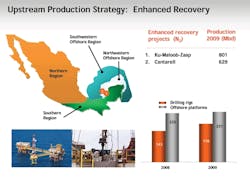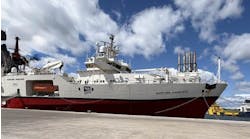Installation of LoFS monitoring at Ekofisk shows system potential
Jan Langhammer
Optoplan, a Sercel company
Fiberoptic systems are ideal for permanent reservoir monitoring. The installation this year of such a system proves that large fiberoptic ocean-bottom receiver arrays can be produced and installed to exploit the life-of-field seismic (LoFS) concept. Optical sensing technology is an important part of the toolbox to maximize field production in a cost-efficient manner. The decision to install a fiberoptic permanent system at Ekofisk is important, and the “optical oil field” may represent the next significant step in technology for reservoir monitoring and improved hydrocarbon recovery.
With maturing basins and ever deeper and more complex frontiers, the importance of extending the life of and maximizing recovery from producing fields has never been greater.
Hydrocarbon exploration and development has seen several step-change technologies during recent decades; time-lapse, or 4D, is a seismic method whose value now is recognized worldwide. In fact, in mature basins such as the North Sea, Gulf of Mexico, and Brazil, 4D seismic reservoir monitoring is seen as mandatory by some operators.
Where frequent surveys are required to monitor a reservoir over its lifespan, a permanent receiver array installation using ocean bottom cables (OBC) is the most cost-effective solution. The additional benefits of such an installation using fixed, trenched cables include full freedom in azimuth and offset, better receiver coupling and repeatability, and low background noise. Together, these increase sensitivity to production effects in the reservoir.
One bottleneck for marine 4D seismic monitoring is vessel availability. However, with a permanent receiver array, the timing of monitor surveys can be more flexible and frequent since only a source boat is required. This improves turnaround and provides “seismic on demand.” In addition, between surveys passive seismic monitoring can be conducted to “listen” for microseismic events in the reservoir and overburden due to stress changes and pressure depletion.
Given this context and increasing interest in permanent LoFS monitoring systems, Optoplan has introduced Optowave, a purely optical solution which offers many advantages over traditional electrical systems.
Pure fiberoptic solution
Optoplan was established in 1985, and pioneered fiberoptic sensing within the oil and gas industry with the first ever in-well installations of optical sensing systems in the 1990s. In 2007 its focus shifted from in-well applications to seabed applications of optical technology. The interest in fiberoptics comes from the telecom industry which was revolutionized by development of fiberoptic components for data transmission. This technology has established a base for advanced sensing systems where fiberoptic components are used for both data transmission and sensing. These advances are now having an impact on the technological development on the seismic industry.1
One advantage of fiberoptic sensors over electric sensors is that they do not require any electronic components or electrical power at the sensing point. The only electronic components in these systems are above water (on a rig for example) where the data is recorded. This makes them inherently safer and more reliable, and eliminates the familiar electrical problem of “leakage.”
Optowave development has involved several small-scale tests, and led to installation this year of a full-blown monitoring system of 200 km (124 mi) of trenched fiberoptic seismic receiver cables over the Ekofisk field in Norway. Installation of the seismic system on Ekofisk is expected to enhance the remaining production, which will extend the life of the field and, in addition, ensure optimal location of future production wells.
A key advantage to this sensor technology is greater durability and reliability. The longer life components, high sensitivity, high dynamic range, lower intrinsic noise, lack of corrosion of sensing components, fewer parts, and higher reliability give the advantage. The goal is for fiberoptic sensors to provide data over the life of the field without the need for costly recovery, repair, and re-trenching, so that there are lower maintenance costs. In addition, it is potentially cheaper to produce fiberoptic systems. All these factors make fiberoptic technology the choice for LoFS which aims to operate for 15-25 years.
In terms of seismic data quality, fiberoptics provide increased bandwidth and precise, stable signals due to the uniform ground-station coupling of the optical sensors. It is a multicomponent (4C) system which records both pressure and acceleration data. These have many added-value applications, including the ability to image through gas-bearing zones (especially useful in monitoring a gas field such as Ekofisk); increased freedom in multiple attenuation via hydrophone-geophone summation; and improved reservoir characterization via multicomponent lithology and fluid discrimination and fracture/stress characterization.
Optical sensing technology
Each 4C ocean bottom seismic station consists of an optical 3C-accelerometer and a fiberoptic hydrophone. An optical fiber section between two fiber Bragg gratings (FBGs) is the active sensing element. The interferometric sensing principle of optical sensors is ideal for dynamic measurements providing ultra-high resolution and high dynamic range. Accelerometers (x, y, and z) are mounted orthogonally to each other and consist of fiber wound on moving-mass coils. The hydrophone consists of fiber wound on an air-backed mandrel, while the last coil acts as a reference interferometer for common mode noise reduction.
When subject to an external force, the fiber length in each sensor changes as a result of the disturbance in the active sensing element. This creates phase changes of the laser light propagating in the fiber. Using optical interferometric techniques, the fiber length changes can be measured accurately, and the corresponding phase changes of the light are converted to seismic wavelets at the topside instrumentation.
An opto-electronic topside recording system interrogates a number of sensors and receiver stations. A complete subsea receiver spread is built up by several array cable modules through a number of down-lead fibers, forming a sufficient total length of sensor cables to cover any zone of interest of the producing field. There is also potential to combine this system, intended for permanent reservoir monitoring, with systems previously developed for in-well applications. After the advanced demultiplexing and transformation of phase changes of laser light to standard seismic traces, the data is transferred to a conventional seismic recording system, usually in the client office, for storage, QC, and data management.
In principle, there is no limit to the number of sensor channels that can be multiplexed. Increasing the number of cable modules only requires an increased number of fibers in the lead-in cable. With the small dimension of optical fibers, a cable with a diameter of a few centimeters can contain in the order of 1,000 fibers. This is sufficient for any permanent seafloor seismic cable network.
Field tests, system installation
The performance of the system has been verified in several small-scale field tests.2,3,4 An Optowave test of 10-km (6-mi) long cable was installed and qualified at the Statoil-operated Snorre field in the North Sea in 2008.5,6 The main goals of the project were to achieve insight into installation, data acquisition, and monitoring procedures. The test objectives were met.
The breakthrough for Optoplan was the award in 2008 to supply a system to monitor Ekofisk field in the North Sea. The operator concluded that the increasingly complex reservoir, with decreasing 4D seismic changes over the years, needed more frequent surveys with higher repeatability and sensitivity.7,8 The solution was a permanent seismic recording system trenched about a meter into the sea floor. The of installation involved 200 km (124 mi) of seismic cables, covering about 60 sq km (23 sq mi) of the field, using 4,000 sensor stations, the largest installation to date. Dedicated installation equipment was developed for the Ekofisk LoFS project to facilitate installation and reduce cost. Installation is to be finished by the end of this year. The LoFS system at Ekofisk will provide data to improve understanding of reservoir depletion zones and intra-reservoir injected water expansion fronts. This is expected to lead to drilling of future production wells with better precision for increased hydrocarbon recovery.
Subsea cable network with topside instrumentation. The network is connected to the platform through fiberoptic seabed backbone cables and a riser cable.
In addition, the converted-wave data (PS data) can be used to improve structural imaging of the gas-obscured area at the crest of the field, and to reduce drilling risk in the overburden. The trenched seismic system will allow cost-efficient, high-quality, and highly repeatable 3D/4C seismic surveys twice a year, which will fulfil the concept of “seismic-on-demand.”
The topside electro-optic recording system connects via a fiberoptic subsea telecommunication cable to offices in Stavanger, Norway, where a CGGVeritas processing center has been established for fast turnaround of time-lapse seismic data volumes. Fast turnaround is essential for using 4D data volumes in future well planning.
Editor’s Note: Optoplan is owned by Sercel, the geophysical equipment division of CGGVeritas.
References
[1] Eriksrud, M., Langhammer, J. and Nakstad, H., [2009] Towards the optical oil field, 79th SEG Annual Meeting, Expanded Abstracts, 3400-3403.
[2] Thompson, M., Amundsen L., Karstad P.I., Langhammer J., Nakstad H. and Eriksrud M., [2006] Field trial of fibre-optic multi-component sensor system for applications in ocean bottom seismic, 76th SEG Annual Meeting, Expanded Abstracts, 1148-1152.
[3] Thompson, M., Amundsen L., Nakstad H., Langhammer J. and Eriksrud M., [2007] Field trial of a fibre optic ocean bottom seismic system, 69th EAGE Conference & Exhibition, Extended Abstracts, P192
[4] Langhammer. J., Nakstad H., Eriksrud M., Berg A., Rønnekleiv E. and Waagaard O.H., [2008] Fibre optic reservoir monitoring: field trials and results, OTC technical Conference and Exhibition, Expanded Abstracts, OTC 19391
[5] Morton, A., Andersen M., Thompson M., [2009] Field Trial of Focused Seismic Monitoring on the Snorre Field, 71st EAGE Conference & Exhibition, Extended Abstracts, X026
[6] Morton, A., Andersen M., Probert T., [2009] Focused seismic monitoring: From acquisition to interpretation in 48 hours: 79th SEG Annual Meeting, Expanded Abstracts, 865-868.
[7] Folstad, P. G., [2010] Fiber optic sensor technology for permanent seismic monitoring at Ekofisk, Biennial Geophysical Seminar, Norwegian Petroleum Society, Expanded Abstracts, 100-103.
[8] Folstad, P. G., [2010] Monitoring of the Ekofisk field, GeoExpro, Issue No. 3.
Offshore Articles Archives
View Oil and Gas Articles on PennEnergy.com






